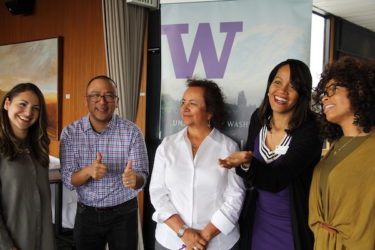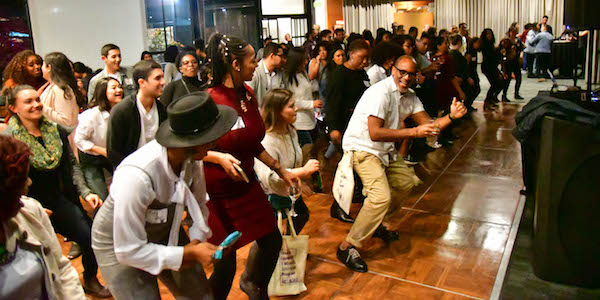Recently, two graduate students from Chemistry, Sarah Vorpahl and Nick Montoni, organized and led a day-long gathering focused on Strengthening STEM through Diversity. The meeting brought together leaders from UW student organizations, as well as faculty, staff, and community partners to collectively discuss issues of equity in STEM and to develop concrete strategies that will promote a climate of inclusivity for multiple underrepresented communities studying, researching, and working in STEM disciplines.
Core Programs attended and gathered several pearls of wisdom from the plenary speaker UW bioengineering faculty Wendy Thomas, and from the student leadership panel, with representatives from Women in Chemical Sciences, oSTEM, SACNAS, AISES, and the student union UAW 4121. We will be sharing highlights and insights, and working on larger institutional guidance, over the next several weeks as the ideas and opportunities identified at the event will contribute to a larger learning environment where all students can thrive at UW. Here is just a start:
Imposter syndrome. “Imposter syndrome” is familiar to many in Graduate School (and beyond): that feeling that you aren’t smart enough or that you might not have what it takes to succeed. Here’s the thing, you are not alone! Surrounded by smart people, many of us may feel we don’t fit in. Some advice has been to “fake it til you make it.” We agree and yet this should not be confused with “suck it up and deal.” That is, if there are things within your grad program or research group that seem odd to you – ask questions, talk to a peer or trusted colleague to check out your observations, seek allies to support you and who can also speak up and ask for changes. Asking for what you need to thrive is a big part of making your graduate experience your own and one in which you can shine. Shifting our academic culture and landscape to a place that encourages human connection and growth will take all of us–from interpersonal changes to institutional, structural level changes.
Develop a growth vs. fixed mindset. Fixed mindset is the belief that “some people just have what it takes,” while others will never have what it takes. It is the thinking that some individuals are automatically good at understanding concepts and theories in their discipline, writing, acquiring research funding, public speaking, and so forth. This is simply not true. Being a graduate student is about developing and honing your skills, knowledge-base, and competencies over time. It is a process. In this regard, we encourage you to shift towards a growth mindset. If you are experiencing a roadblock in graduate school, it is more than likely that a peer or faculty has experienced a similar challenge. If you are part of the 1-in-3 graduate students who are coping with issues related to mental health, utilize campus resources like the DRS. DRS staff can help you draft an accommodation plan that is personal, confidential, and can set you up for success. Graduate school is a marathon, not a sprint, so pace yourself and give yourself permission to grow.
Find a mentor. There are numerous reasons why you seek out mentors in graduate school. An advisor can give you research direction, but a mentor really invests in you. National guidelines are now pointing to building a mentor team for academic direction, career guidance, and personal support. Mentors can make the difference between surviving and thriving – seek them out and invest time to build your team. As keynote speaker Dr. Thomas shared, when she finally had a mentor who was equally excited to talk to her about her research results, as well her feelings about the research, she knew she could stay in academia.
We thank the student event organizers, student organizations, and the UW programs that signed on as co-sponsors, for their dedication and hard work in investing in making UW a better place for all of us! Keep it coming. #Together #DiversifySTEM #UWGradSuccess
Best Regards,
Kelly, Jaye, and Ziyan
Core Programs Team


